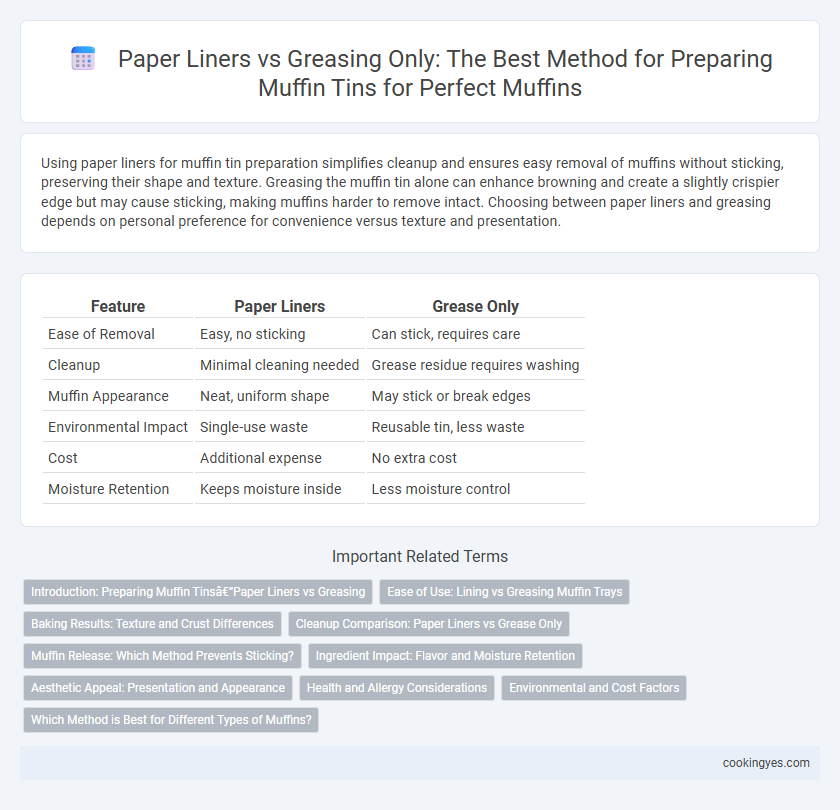Using paper liners for muffin tin preparation simplifies cleanup and ensures easy removal of muffins without sticking, preserving their shape and texture. Greasing the muffin tin alone can enhance browning and create a slightly crispier edge but may cause sticking, making muffins harder to remove intact. Choosing between paper liners and greasing depends on personal preference for convenience versus texture and presentation.
Table of Comparison
| Feature | Paper Liners | Grease Only |
|---|---|---|
| Ease of Removal | Easy, no sticking | Can stick, requires care |
| Cleanup | Minimal cleaning needed | Grease residue requires washing |
| Muffin Appearance | Neat, uniform shape | May stick or break edges |
| Environmental Impact | Single-use waste | Reusable tin, less waste |
| Cost | Additional expense | No extra cost |
| Moisture Retention | Keeps moisture inside | Less moisture control |
Introduction: Preparing Muffin Tins—Paper Liners vs Greasing
Choosing between paper liners and greasing for muffin tin preparation significantly impacts baking results and cleanup. Paper liners provide non-stick convenience, ensuring muffins release easily and retain moisture, while greasing tins offers a customizable coating to prevent sticking and create a crispier crust. Understanding the pros and cons of each method optimizes texture, appearance, and baking experience for perfect muffins every time.
Ease of Use: Lining vs Greasing Muffin Trays
Paper liners offer a convenient, mess-free option for muffin tin preparation, eliminating the need for thorough greasing and simplifying cleanup. Greasing muffin trays requires evenly coating each cup with butter or oil, which can be time-consuming and may result in uneven non-stick performance. Choosing paper liners ensures consistent muffin shape and easy removal, making them a preferred choice for both novice and experienced bakers.
Baking Results: Texture and Crust Differences
Using paper liners in muffin tins results in a softer crust and more uniform texture by retaining moisture within the batter, while greasing tins allows direct heat contact that creates a crisper, golden-brown exterior. Muffins baked with grease-only tins often develop a slightly thicker crust and may brown faster due to reduced moisture retention compared to those baked with paper liners. Choosing between liners and grease affects not only cleanup convenience but also the final muffin's crumb structure and crust crispness, influencing overall taste and mouthfeel.
Cleanup Comparison: Paper Liners vs Grease Only
Paper liners significantly simplify cleanup by preventing batter from sticking to the muffin tin, allowing for quick removal and minimal residue. Grease-only preparation requires thorough scrubbing and often soaking to eliminate baked-on oil and crumbs, increasing cleanup time and effort. Choosing paper liners reduces post-baking mess and preserves the muffin tin's condition by minimizing direct contact with grease and batter.
Muffin Release: Which Method Prevents Sticking?
Paper liners provide a reliable barrier between muffins and the tin, significantly reducing the risk of sticking and ensuring easy removal. Greasing only can work well with a generous application of butter or oil, but often leads to uneven release and potential muffin breakage. For consistent muffin release and maintaining muffin integrity, paper liners are the preferred choice.
Ingredient Impact: Flavor and Moisture Retention
Using paper liners for muffin tins helps retain moisture by creating a barrier that locks in steam during baking, enhancing the muffin's softness and preventing dryness. Greasing the tin alone allows batter to directly contact the metal, which can lead to slightly crispier edges but may result in moisture loss and subtle changes in flavor profile. Ingredient sensitivity, such as the inclusion of high-fat or fruit components, benefits from paper liners as they preserve delicate flavors and maintain optimal texture.
Aesthetic Appeal: Presentation and Appearance
Using paper liners enhances the aesthetic appeal of muffins by providing a clean, uniform look and vibrant colors or patterns that complement the baked goods, making them visually appealing for presentations and events. Greasing the muffin tin alone can result in uneven edges and a less polished appearance, potentially causing muffins to stick and break apart, which negatively impacts presentation quality. Paper liners also prevent grease stains on muffin surfaces, maintaining a fresh and appetizing look that is ideal for display and serving.
Health and Allergy Considerations
Using paper liners in muffin tins reduces direct contact between batter and metal, minimizing contamination risks and easing cleanup for individuals with allergies or sensitivities. Greasing tins alone can lead to more residue buildup, increasing the chance of allergen cross-contact if thorough cleaning is not maintained. Paper liners provide a hygienic barrier that supports better health safety and allergen control during muffin preparation.
Environmental and Cost Factors
Using paper liners for muffin tins increases convenience but generates additional waste, impacting environmental sustainability due to paper production and disposal. Greasing the tin alone reduces waste and eliminates the need for single-use liners, lowering long-term costs and environmental footprint. However, greasing requires thorough cleaning, which may increase water and detergent use, balancing some environmental benefits.
Which Method is Best for Different Types of Muffins?
Paper liners provide superior moisture retention and easy cleanup, making them ideal for sticky or delicate muffins like blueberry or banana nut. Greasing muffin tins enhances browning and crisp edges, preferred for dense, batter-heavy muffins such as bran or corn muffins. For hybrid or specialty muffins, a combination of greasing and using liners can balance texture and prevent sticking.
Paper Liners vs Grease Only for Muffin Tin Preparation Infographic

 cookingyes.com
cookingyes.com